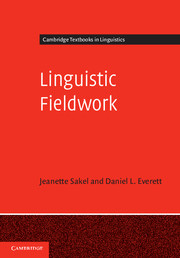6 - Fieldwork methods
Published online by Cambridge University Press: 05 December 2012
Summary
This chapter deals with the methods of different types of fieldwork. Fieldwork can involve naturalistic, controlled or reported data; methods can be qualitative and/or quantitative, including elicitation, recording of spoken language and linguistic experiments. Still, even the most distinct types of fieldwork often make use of similar processes, such as recording metadata.
In this chapter, we will discuss the different methods employed in fieldwork. How you employ these methods largely depends on your goals. If your aim is to write a grammar, you may well use all of the methods. If your aim is to look at a particular structure in a well-described language, you may be able to get away with just one method.
Likewise, the timescale of your studies depends on what you are doing. For example, when conducting a pilot study (like the Somali study in 2.2) you may be able to collect your data in short sessions arranged to suit your and your speakers’ availability. When writing a grammar, some field linguists work with language teachers eight hours a day, seven days a week, the entire time that they are in the community. Others find that a less intensive schedule works better. It is up to you to find a way that works for you, your teachers and your project.
- Type
- Chapter
- Information
- Linguistic FieldworkA Student Guide, pp. 99 - 138Publisher: Cambridge University PressPrint publication year: 2012



